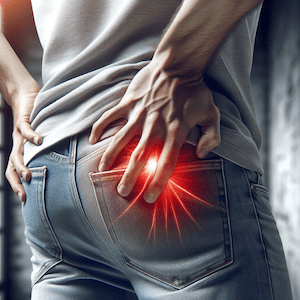Piriformis Syndrome
Article by Alex Clarke

Piriformis Syndrome
A Pain in the Buttock
Have you ever felt a sharp pain in your buttock or down your leg while sitting for too long? It might be more than just discomfort from staying in one position. You could be experiencing Piriformis Syndrome, a condition often mistaken for sciatica that affects many Australians every year.
What Exactly is Piriformis Syndrome?
Piriformis syndrome is a neuromuscular disorder that occurs when the piriformis muscle, located in the buttock region, spasms and causes pain. This muscle is essential for lower body movement because it stabilises the hip joint and lifts and rotates the thigh away from the body. When it spasms, it can irritate the nearby sciatic nerve, causing pain, tingling, and numbness in the buttock and along the path of the nerve descending down the back of the thigh.
Symptoms to Watch For
The most common sign of Piriformis Syndrome is sciatica-like pain in the buttock and leg. Other symptoms include:
- Numbness or tingling down the leg
- Increased pain after prolonged sitting
- Painful to touch the area around the piriformis muscle
- Difficulty sitting comfortably
- Discomfort during bowel movements or sex
These symptoms can disrupt daily life, making even simple tasks painful.
Common Causes and Risk Factors
Several factors can contribute to the development of Piriformis Syndrome:
- Muscle spasms in the piriformis muscle due to injury or irritation
- Overuse from long periods of sitting or vigorous activity
- Uneven leg lengths
- Prior hip surgery
- Pelvic imbalances
Understanding these factors can help in managing and preventing the syndrome.
Understanding the Connection: Core Weakness and Its Impact on Piriformis Syndrome and Related Conditions
Piriformis syndrome often links to a chain of related musculoskeletal issues. Primarily, core weakness plays a pivotal role. Weak abdominal and back muscles fail to provide adequate support for the pelvis, leading to an imbalance. This imbalance stresses the sacroiliac (SI) joint, which can manifest as sacroiliac conditions.
Similarly, Greater Trochanteric Pain Syndrome (GTPS), often associated with lateral hip pain, can also stem from this instability. Moreover, gluteal weakness compounds the problem. The gluteal muscles, crucial for stabilising the hip and pelvis, when weak, place additional strain on the piriformis muscle. This strain exacerbates the discomfort and symptoms of Piriformis syndrome. In essence, these interconnected conditions often stem from and contribute to the underlying issue of core and gluteal weakness.
Diagnosis: More Than Just Symptoms
Diagnosis of Piriformis Syndrome begins with a thorough clinical examination. Your healthcare provider will check for pain in the buttock area with certain leg movements. They may also perform imaging tests like MRI or CT scans to rule out other causes of your symptoms.
Piriformis Syndrome
Effective Treatment Strategies
Once diagnosed, several treatments can alleviate the symptoms of Piriformis Syndrome:
- Targeted Physiotherapy: A physiotherapist can guide you through exercises that stretch and strengthen the piriformis muscle.
- Medication: In some cases, anti-inflammatory medications or muscle relaxants may be prescribed to reduce discomfort.
- Hot/Cold Therapy: Applying heat or ice packs can help reduce muscle tension and pain.
- Lifestyle Adjustments: Incorporating ergonomic furniture and taking frequent breaks from sitting can prevent symptoms from worsening.
- Massage Therapy: Deep tissue massage can help relieve muscle tightness and spasms.
The Road to Recovery
With proper treatment, most people with Piriformis Syndrome experience significant improvement. However, long-term management may be necessary to prevent recurrence. This includes:
- Regular exercise and stretching
- Maintaining good posture
- Avoiding prolonged sitting
- Specific strengthening of weak muscles eg core muscles, deep hip rotators
Prevention: Staying Ahead of the Pain
Preventing Piriformis Syndrome involves maintaining a healthy lifestyle with regular exercise, stretching, and avoiding prolonged periods of sitting. Strengthening the muscles around the piriformis and practising good posture can also reduce the risk of developing this painful condition.
Seeking Professional Advice
If you suspect that you have Piriformis Syndrome, it’s important to consult a healthcare professional. They can provide a personalised treatment plan to manage your symptoms effectively.
Conclusion: Taking Action Against Piriformis Syndrome
Living with Piriformis Syndrome can be challenging, but with the right approach, it’s manageable. Please book an appointment with us should you suspect Piriformis Syndrome.
Related Articles
- Sciatica Treatment & Management Strategies – Readers will learn about different approaches to managing sciatica, which is often confused with Piriformis Syndrome.
- Sacroiliac Joint Dysfunction (SIJ) Causes, Relief, Treatment – This article explains the relationship between SIJ dysfunction and Piriformis Syndrome, offering insights into causes and treatments.
- Trochanteric Bursitis – Hip Bursitis: Causes & Treatments – Offers information on another condition affecting the hip area, which could be of interest to those learning about Piriformis Syndrome.
- Core Stability: A Physiotherapist’s Guide For Spinal Health – Highlights the importance of core stability in managing conditions like Piriformis Syndrome, providing exercises and tips.
- Gluteal Tendinopathy: Causes, Symptoms, And Treatment – Discusses gluteal tendinopathy, which can occur alongside or be mistaken for Piriformis Syndrome, with a focus on treatment options.
- Deep Hip Rotators – Provides insights into the role of deep hip rotators, including the piriformis muscle, in hip stability and pain, relevant for those with Piriformis Syndrome.
- Greater Trochanteric Pain Syndrome (GTPS) – Explains GTPS, a condition causing pain outside the buttock and thigh, relevant for understanding related hip and buttock pain.
- Hip Labral Tear – Information on hip labral tear symptoms, causes, and treatments, useful for individuals exploring different sources of hip pain.
- Proximal Hamstring Tendinopathy – While focusing on a different condition, this article can help differentiate between hamstring-related pain and Piriformis Syndrome.
- Pilates For Back Pain – Discusses the benefits of Pilates for managing back pain, which can be complementary information for those with Piriformis Syndrome.
































































